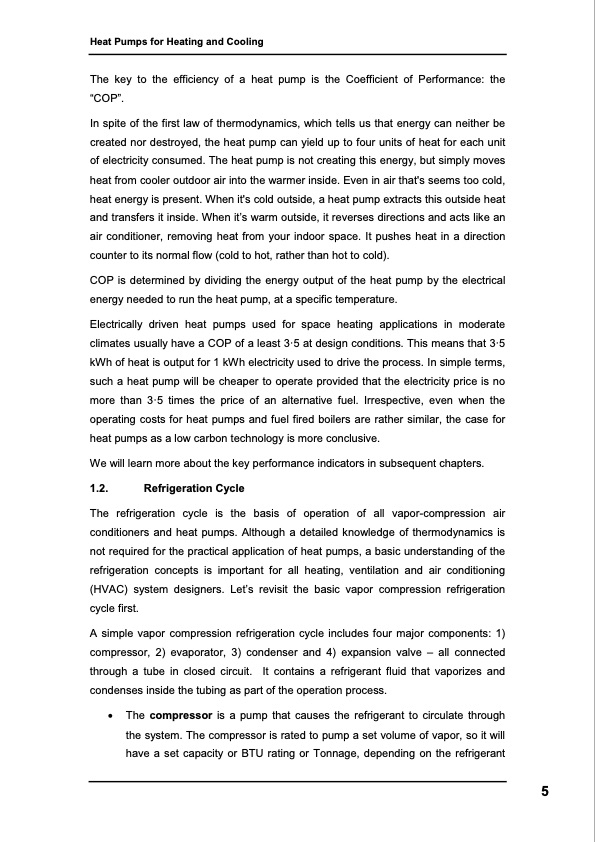
PDF Publication Title:
Text from PDF Page: 006
Heat Pumps for Heating and Cooling The key to the efficiency of a heat pump is the Coefficient of Performance: the “COP”. In spite of the first law of thermodynamics, which tells us that energy can neither be created nor destroyed, the heat pump can yield up to four units of heat for each unit of electricity consumed. The heat pump is not creating this energy, but simply moves heat from cooler outdoor air into the warmer inside. Even in air that's seems too cold, heat energy is present. When it's cold outside, a heat pump extracts this outside heat and transfers it inside. When it’s warm outside, it reverses directions and acts like an air conditioner, removing heat from your indoor space. It pushes heat in a direction counter to its normal flow (cold to hot, rather than hot to cold). COP is determined by dividing the energy output of the heat pump by the electrical energy needed to run the heat pump, at a specific temperature. Electrically driven heat pumps used for space heating applications in moderate climates usually have a COP of a least 3·5 at design conditions. This means that 3·5 kWh of heat is output for 1 kWh electricity used to drive the process. In simple terms, such a heat pump will be cheaper to operate provided that the electricity price is no more than 3·5 times the price of an alternative fuel. Irrespective, even when the operating costs for heat pumps and fuel fired boilers are rather similar, the case for heat pumps as a low carbon technology is more conclusive. We will learn more about the key performance indicators in subsequent chapters. 1.2. Refrigeration Cycle The refrigeration cycle is the basis of operation of all vapor-compression air conditioners and heat pumps. Although a detailed knowledge of thermodynamics is not required for the practical application of heat pumps, a basic understanding of the refrigeration concepts is important for all heating, ventilation and air conditioning (HVAC) system designers. Let’s revisit the basic vapor compression refrigeration cycle first. A simple vapor compression refrigeration cycle includes four major components: 1) compressor, 2) evaporator, 3) condenser and 4) expansion valve – all connected through a tube in closed circuit. It contains a refrigerant fluid that vaporizes and condenses inside the tubing as part of the operation process. • The compressor is a pump that causes the refrigerant to circulate through the system. The compressor is rated to pump a set volume of vapor, so it will have a set capacity or BTU rating or Tonnage, depending on the refrigerant 5PDF Image | Heat Pumps for Heating and Cooling

PDF Search Title:
Heat Pumps for Heating and CoolingOriginal File Name Searched:
heat-pumps-for-cooling-r1.pdfDIY PDF Search: Google It | Yahoo | Bing
CO2 Organic Rankine Cycle Experimenter Platform The supercritical CO2 phase change system is both a heat pump and organic rankine cycle which can be used for those purposes and as a supercritical extractor for advanced subcritical and supercritical extraction technology. Uses include producing nanoparticles, precious metal CO2 extraction, lithium battery recycling, and other applications... More Info
Heat Pumps CO2 ORC Heat Pump System Platform More Info
| CONTACT TEL: 608-238-6001 Email: greg@infinityturbine.com | RSS | AMP |